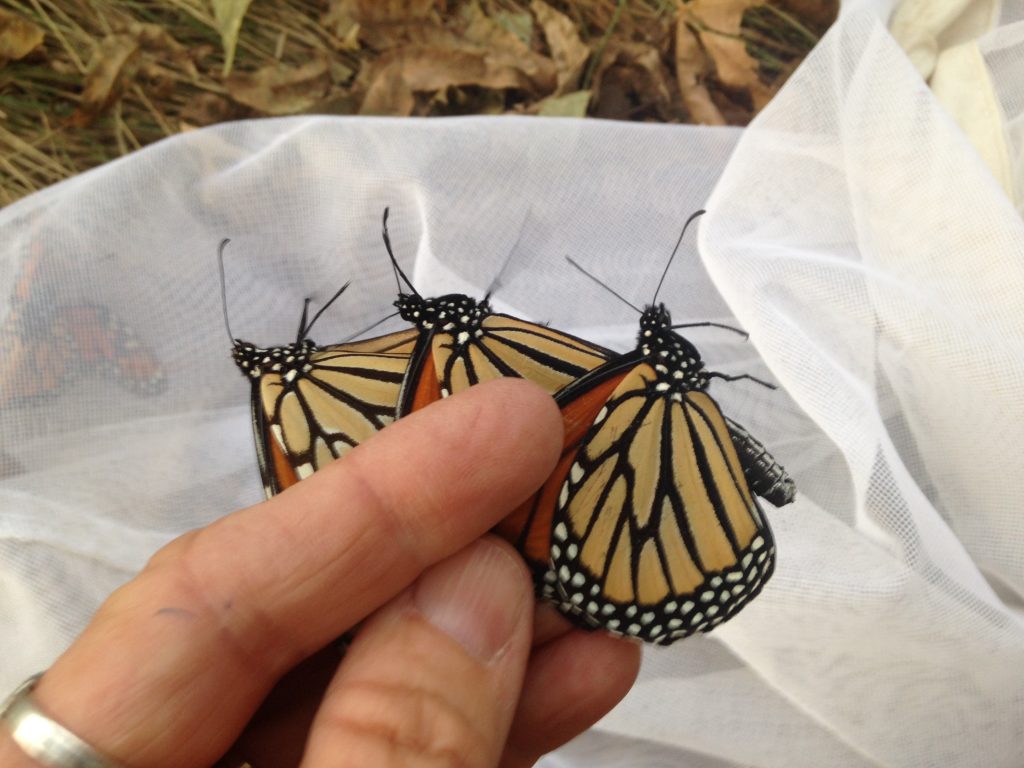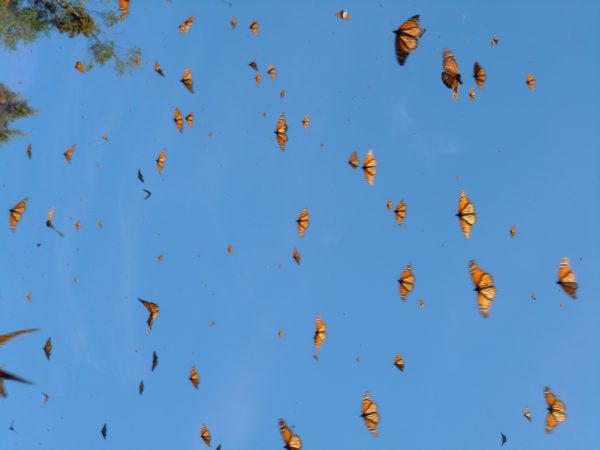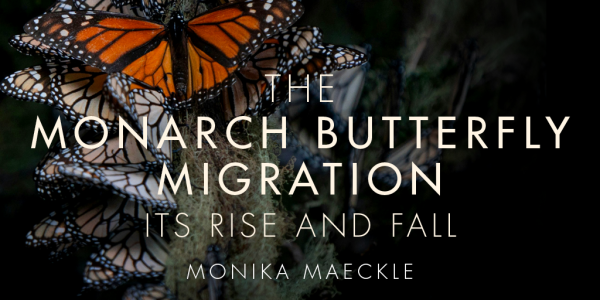The US Fish and Wildlife Service (USFWS) ruled today that monarch butterflies, Denaus plexippus, should be listed as “threatened” under the Endangered Species Act (ESA). The listing will be published in full on Thursday, December 12. A 90-day comment period will follow. Read the USFWS press release here.
The highly anticipated ruling comes after a decade of debate that started in 2014 when a group of monarch butterfly advocates submitted the iconic creatures for consideration.
Monarch butterfly fans anticipate months of havoc as its “threatened” status is clarified. In particular, people who raise, release and handle monarch butterflies–and milkweed–will have many questions as the public comment period unfolds over the coming months. That discussion will determine the 4D rules (ESA parlance for specific directives) that will explain EXACTLY what will and will not be allowed.
Will we still be able to tag monarch butterflies and participate in citizen science? Will cutting back or removing milkweed be against the law? Will festivals, museums, and weddings and funerals still be able to feature monarch butterflies in tagging demonstrations, educational exhibits and symbolic and inspirational releases that capture their magic?

Will we still be able to tag monarch butterflies? –Photo by Monika Maeckle
Such questions will be raised and ruled upon over the coming months. USFWS will host a webinar for stakeholders this Friday, December 13, at 3:00pm EST/12:00pm PT. Here’s the link to join the discussion.
The decision has roots in the 2014 petition put forward by the Xerces Society, Center for Food Safety, the Center for Biological Diversity and the late monarch butterfly entomologist Dr. Lincoln Brower. In December 2014, USFWS published a 90-day finding that listing the monarch might be warranted, and initiated a status review of the species. The federal agency then failed to rule on the petition by the statutory 12-month deadline. A lawsuit ensued, and by 2016, USFWS received a three-year extension. USFWS received another one-year extension in 2019.
In December of 2020, in a case of conservation triage, USFWS determined that listing monarch butterflies was “warranted but precluded”–basically relegating monarchs to the emergency room. They determined that after six years of consideration, the species needed to get in line behind 161 others awaiting protection. The agency then committed to evaluating monarchs every two years. They did so in 2022 (no ruling resulted because of a rebound in the population), and again today. Denaus plexippus, now joins the roster of species that will be protected under the ESA.

Dr. Lincoln Brower: “Don’t you think it’s done some good?”–photo via Monarch Butterfly Fund
Monarch conservation nonprofits were quick to pounce on the fundraising opportunities presented by USFWS’s decision to list the monarch. Within hours of the announcement, Monarch Joint Venture sent out emails announcing the news–along with a plea for donations. “This proposed listing is more than a warning—it’s a call to action. Monarchs are running out of time, and your support can make a difference….Monarchs need more than hope—they need YOU. Will you answer the call? Donate Now.”
National Public Radio and other mainstream news media reported that scientists were pleased about the listing, but in my recent book, The Monarch Butterfly Migration Its Rise and Fall, scientists overwhelmingly agreed that monarch butterflies are NOT endangered–their migration is. The dominant narrative for determining the health of the monarch population for decades has focused on how many butterflies complete the migration. Butterflies are counted in Mexico at the roosting sites, and those numbers are shared. They continue to decline.
That said, some scientists believe that monarchs are changing their habits and many are no longer migrating, but building local populations–in California, along the Texas coast, South Carolina, and Florida. They are reproducing locally and forgoing the arduous journey of migrating. And why not? If food, shelter, mates, host plant and a hospitable climate exist in the neighborhood, why undertake an often fatal migration in order to reproduce and continue the life cycle?
A study released in October by monarch butterfly scientist and migration studies expert Dr. Andy Davis at the University of Georgia found that the monarch butterfly’s breeding population is stable and thriving, while its fall migratory population is in serious decline.
Unfortunately, no possibility exists for listing a phenomenon such as a migration as threatened or endangered under the ESA. Listing the species itself may be the only recourse for protection. As I report in my book, when renown monarch butterfly scientist the late Lincoln Brower was asked whether or not he believed monarch butterflies were approaching extinction, he evaded the question.
Instead Brower responded “Don’t you think it’s done some good?”
TOP PHOTO: Monarch butterflies at the overwintering sites in Mexico. –Photo by Monika Maeckle
Related articles
- New study: monarch migration at risk, monarch butterflies are not
- USFWS rules monarch butterflies worthy of protection, but they don’t have resources to protect it
- As ESA listing looms, new study challenges dogmatic narrative that monarchs are in decline,
- “Weird” weather has scientists concerned about this year’s monarch butterfly migration
- “Snoutbreak” in Central and South Texas: American Snout butterflies inundate Hill Country
- Declining monarch butterflies: Mexico population drops 59%, West coast population down 30%
- Recent IUCN “endangered” listing creates confusion for monarch butterfly fans
- IUCN revises listing of monarch butterfly from “endangered” to “vulnerable”
- Endangered Species Act: wrong tool for monarch butterfly conservation?
- USFWS gets three more years to evaluate monarch butterfly ESA status



Great article. The monarch butterfly is no nearer to extinction in 2024 than 2014. It is less so. The species continues to thrive – and as Monica states, scientists agree that they are not in fact endangered. The migration is changing – but then, migration is changing for many species. That is not the definition of endangered.
By the way, monarchscience.org has a chart from June 11th, 2022 that shows how monarchs are doing compared to other butterflies:
monarchscience.org/single-post/here-is-a-simple-way-to-determine-how-monarchs-are-doing-compared-to-other-butterflies
The immediate call for donations is a bit laughable – and telling. Are these individuals and organizations the squeaky wheel? Their opinion should be considered quite biased. I also get the feeling that they wish to control the narrative by creating rules to their advantage and will not actually benefit the butterfly. My humble opinion.
May cooler heads and rational thinking prevail. I believe that the decline of the monarch butterfly of 2012-2015 has been halted due to backyard citizen scientists. What we are doing is working. Government “help” via non-sensical rules is not beneficial – and may create an actual decline if they interfere with the good work being done.
The new listing doesn’t provide legal protections for the 2,000,000+ milkweed stems growing in the wild so the ongoing landscape scale losses of milkweed and migratory monarch abundance will continue.
Locally where we are we have Twp cutting milkweed plants on road sides , I don’t understand ….they do not care …